- Introduction
- Justification for Change
- Accreditation Standards and Regulatory Requirements
- The Theory Chosen to Drive the Change
- The Potential Impact of the Internal and External Challenges on the Project
- Analysis of the Chart
- Chart for the Data and Trends
- The Two SMART Goals to Facilitate the Plan
- Conclusion
- References
Introduction
- The Central Venous Catheter is important because it enables the patients to receive the essential nutrition and treatment.
- The traditionally accepted Peripheral Inserted Central Catheter tools are among the best ones.
- It is critical to examine the tools and recommend further improvement.
- The study would recommend the desired.
Studies show that PICC lines cannot be deemed as efficient as they expose patients to even greater risks, including the threat of a thrombosis . Therefore, a detailed overview of the tools need to be carried out to determine their efficacy and suggest tools for the further improvement of the nursing services.
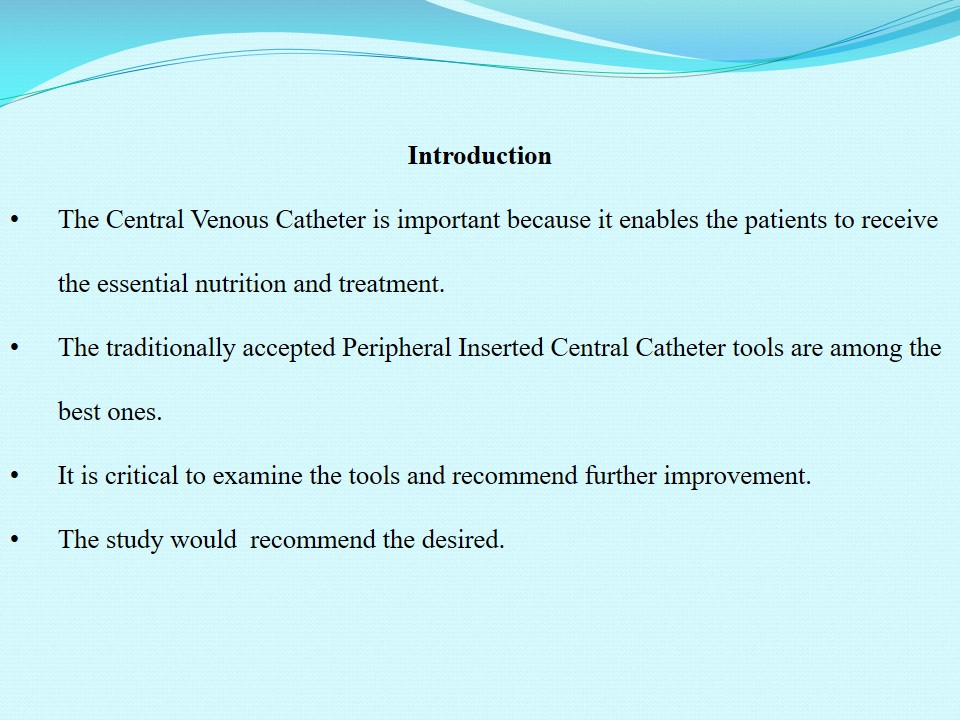
Justification for Change
- PICCs are prone to thrombosis. Thrombosis is a clot of coagulated blood at the site of the insertion in the blood vessel.
- The constant use of PICC causes the rise in infections.
- Some of the tools fail to work due to mechanical problems and complications that are associated with morbidity (Levy, Bendet, Samra, Shalit, & Katz, 2010).
- Some nurses had not received sufficient training on how to use the tools.
- The tools cause discomfort and vein complications.
- The nurses may also fail to get the right nerve during the first insertion. Wrongful insertions cause nerve damage to the blood vessels.
- Needs assessment helps in the identification of the risk factors.
The complications from PICC require proactive actions to guarantee the safety of patients . In this case, the needs assessment offers a central tool for identifying the immediate areas of actions to reduce the implications of the PICC on patients’ health. The questions provided in the assessment survey help in the process of identifying the urgent needs that must be addressed to reduce the complications brought about by the use of the Peripherally Inserted Central Catheters (Kaufman & Guerra-Lopez, 2013).
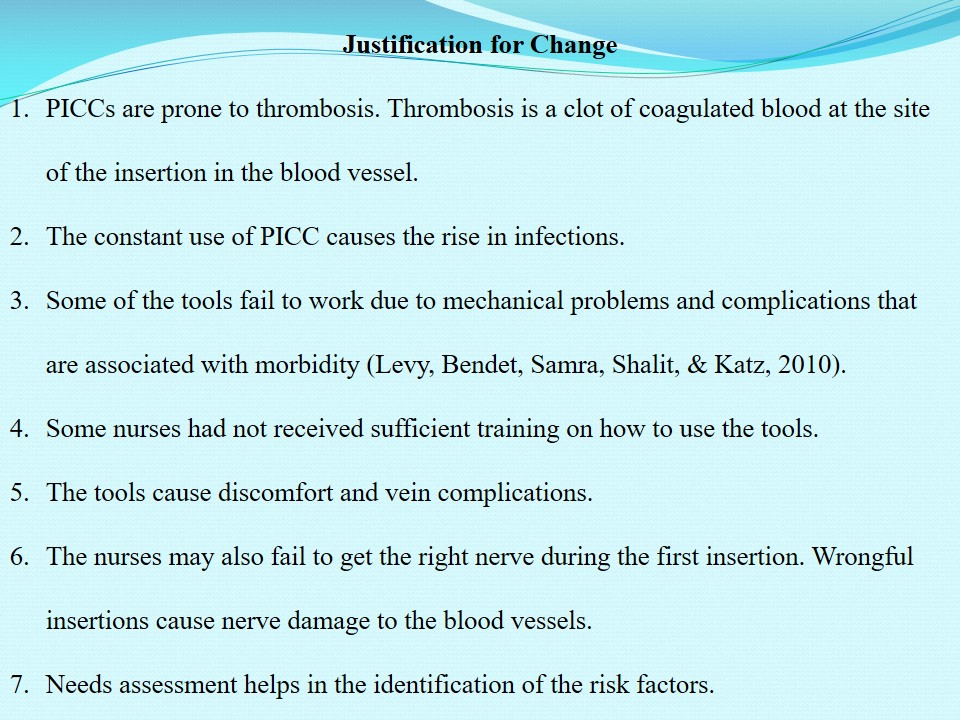
Accreditation Standards and Regulatory Requirements
Physicians and nurses should satisfy multiple related accreditation standards and guidelines. They are provided by various stakeholders in PCCI line care provision. The following are examples;
- The Infusion Nurses Society (INS) has Standards of Practice. They provide standards on catheter clearance and determine the role of Registered Nurses on Tip Placement and performance.
- The American College of Radiology (ACR) has the Gold Standard of Accreditation. It offers standards of imaging quality and patient safety during CT.
- The State Nursing Board continuously issue new procedures and guidelines for nurses on PCCI line placement.
Additionally, other accreditation standards are also available to ensure safe, effective PCCI line. These standards focus on medical imaging and radiation therapy, general conditions of clinical settings and safe, effective use of ultrasound.
The federal law requires every state to have its sets of rules and regulation on PICC Line insertion programs. As such, today, every state has, at least, one or more regulations on PCCI line insertion. They majorly focus on the role of nurses, facility conditions, and x-ray requirements among others. Nurses can legally insert PCCI line across the US, but there are specific provisions and restrictions on the roles of nurses (Infusion Nurses Society, 2013).
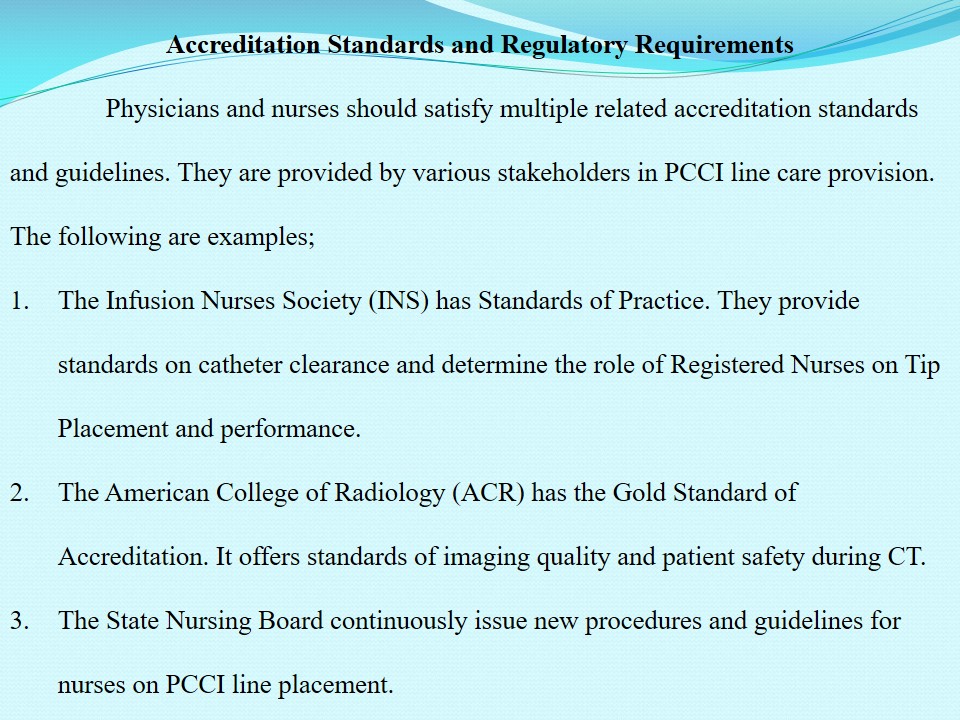
The Theory Chosen to Drive the Change
Reasons for the Choice
- They would provide guidance on the process and the approach that is intended in the practical application of the project ideas.
- Patricia Benner’s Novice to Expert Theory provides the path for instructing nurses according to their expertise.
- It would be very helpful to focus on the nurses’ strengths and weakness to prioritize the education needs that promote the continuing development process.

Novice to Expert Theory
According to Benner, every nurse goes through five levels of experience. They include:
- Novice;
- Advanced beginner;
- Competent;
- Proficient;
- Expert.
The levels are not reached by exposure to theoretical knowledge. They are reached by application of the abstract knowledge obtained in the past to the reality which demands practice.

The Caring Theory
- It is Jean Watson who developed the caring theory.
- The theory suggests that there should be emphasis on respect and love projected towards the patient.
- Care should be heart-centered and based on the wholeness of the mind, body and spirit.
- It should also maintain the inner harmony, among other things.
- Although the Caring Theory may have some conflicting differences with the project’s suggested philosophy and the previous theory, it benefits the project in many ways.

Other Theories
- There are other nursing models that fit in this particular case.
- They usually exhibit similar goals and approaches and differ primarily in the priorities and details.
- Orem’s model is well-placed for this project. According to Dorothea Orem, both the patient and the nurse should work towards sustaining self-care, or make the patient as independent as possible.
- The approach can ensure the patient’s active participation in the treatment process and add a layer of control.
Additional Theories Include: Jean Watson’s Caring Theory focuses on the patient-centered care which is the motto for our daily exercise of the nursing profession at Kendall Regional Medical Center. Motivating nurses through continuing education will lead to achieving the utmost goal: a comprehensive and excellent patient/family care, and at the same time, reduce the complications of PICC lines in patients that required long treatment periods. Consequently, we will be able to promote health with a comprehensive approach.
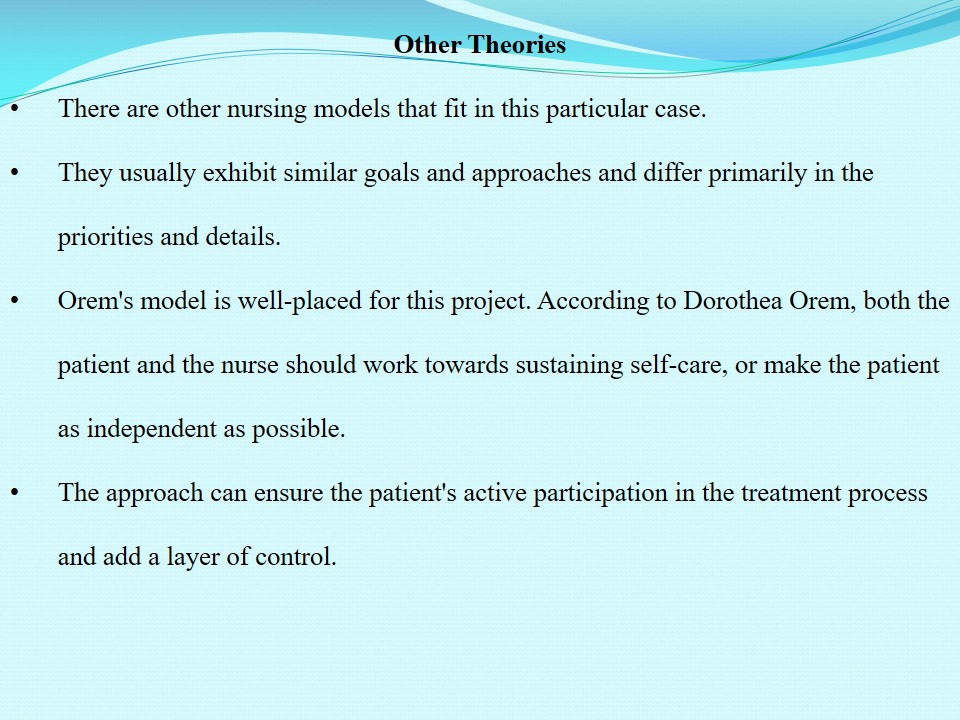
The Potential Impact of the Internal and External Challenges on the Project
External Forces
- The context within which health care is practiced affects a variety of cultures and communities. It is influenced significantly by political, economic and social factors.
- Marsden (2013) states that application of technology is crucial to enhancing the efficiency, as well as promoting the overall realization of quality care.
- According to Pai and Huang (2011), lack of refresher programs on computer technology among health practitioners acts as a major impediment towards the effective implementation of change in service delivery.
- The inefficiency of refresher programs results from lack of enough funding for retraining and capacity building.
- The minimal understanding of healthcare environments by Information Technology (IT) experts involved in the management of hospital technology is also a major concern.
- The education level of nurses also has a great impact on the implementation of change in a health care setting.
These external forces substantially impede the implementation of proposed changes in the healthcare technology.
With the training of medical information technology specialists, improvement can be realized in the communication processes between IT specialist and the health practitioners.
Various internal and external factors pose a threat to the implementation of changes in nursing practice. Technology issues may impede the actualization of change in the case where nurses are not aware of the technicalities involved. Structural organization of the health institution impacts on the progress in change based on the leadership methods utilized. Thus, to overcome slow implementation of change, health systems should embrace collaborative research, and leaders should foster strong working relationships where communication is adequate vertically and horizontally within the leadership hierarchies.
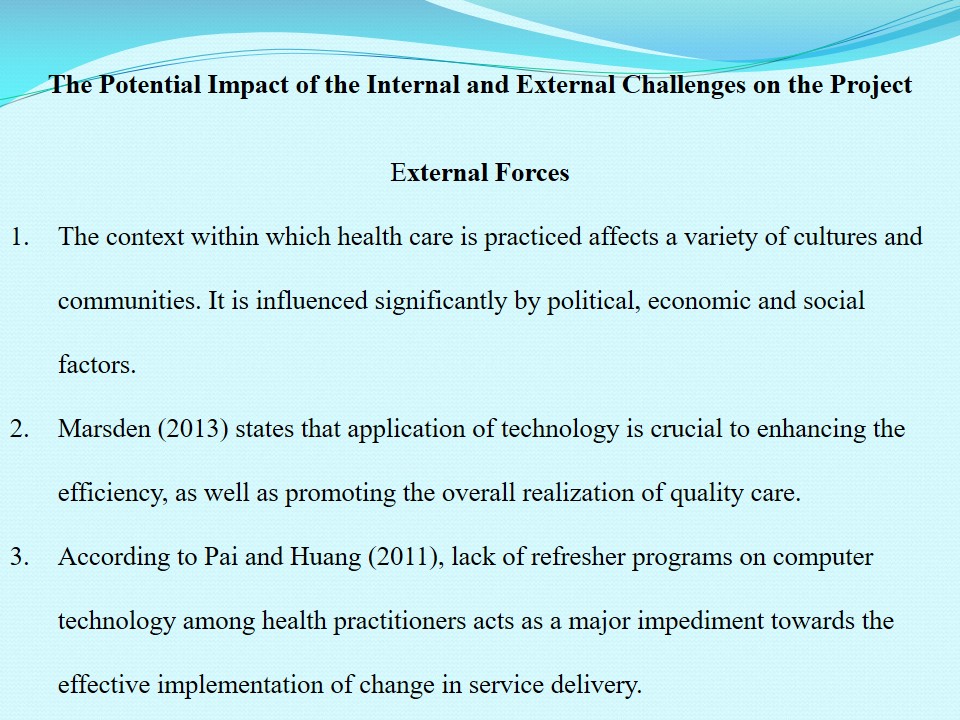
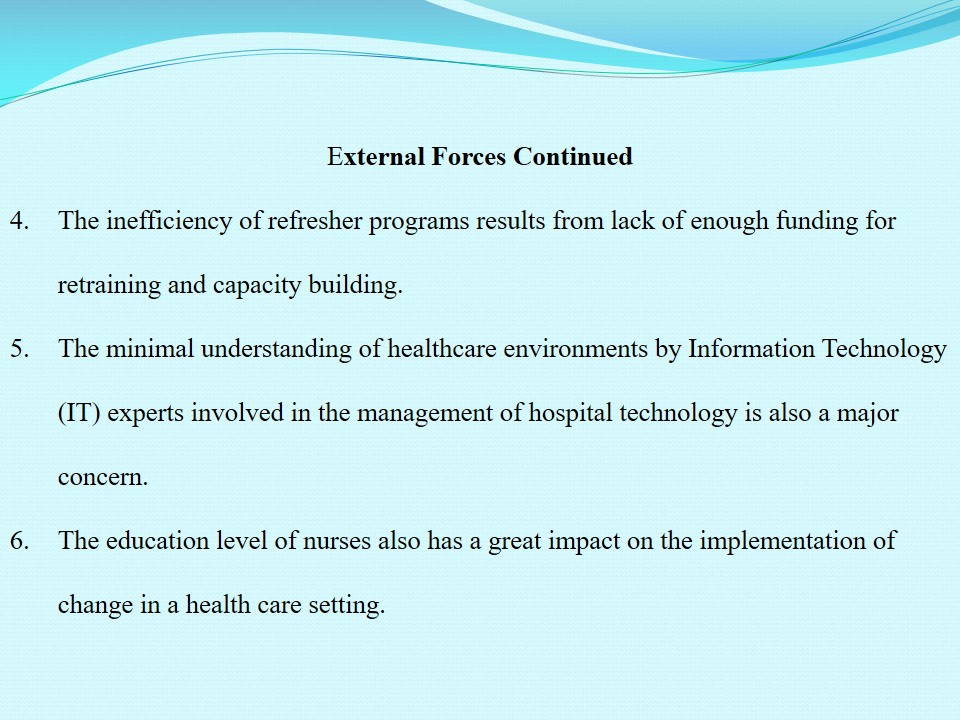
Internal Forces
- The age of most of the computer equipment being used in PICC line insertions are getting outdated.
- Rycroft-Malone et al. (2013) indicate that organizational structure is a major internal force that significantly affects the structural changes in the health care settings.
- Organizations that facilitate research and learning bring about change in their structural systems and thus the need for coping with the mechanism to ensure positive outcomes.
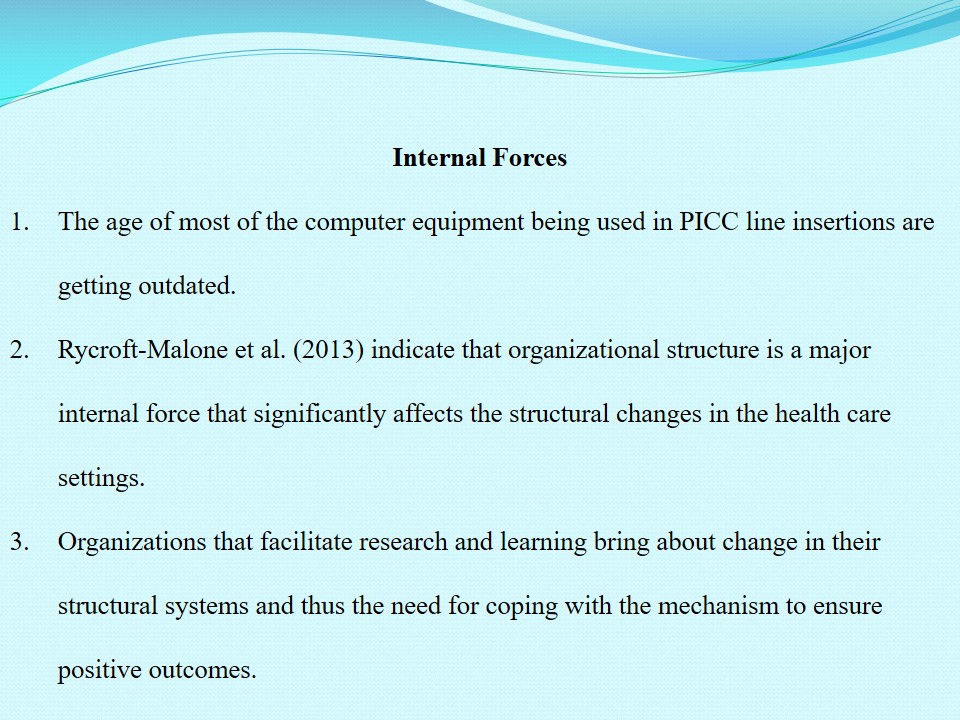
Internal Forces Solutions
- Transformational leaders encourage teamwork, value the contribution of every person to the organizational growth, and build an innovative culture in the working environment (Marsden, 2013).
- The organization should also decentralize its decision-making organs.
- Having a motivated workforce, precise roles and continuous access to update information to the personnel enhances nurses’ knowledge and skills.
Nurses’ resistance to change constitutes an internal force that impedes implementation of new plans in the health care system. The reason for this resistance may come from extensive criticism of the new system, the system design, and the working culture of the nurses (Pai & Huang, 2011).
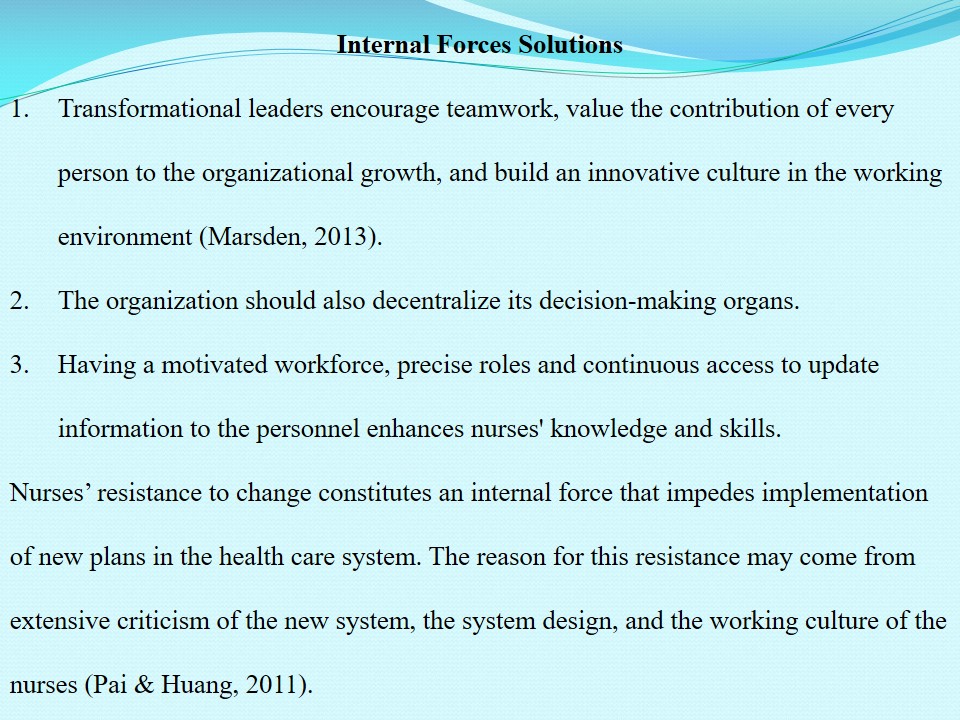

Analysis of the Chart
- The frequency of complications are approximately equal to 17-23 days per every 1000 days that patients have PICC installed.
- The significant barrier precautions can lead to a much lower amount of complications.
- It is evident from some of the reviewed articles (Barrier et al., 2012; Gasior et al., 2013; (Koo et al., 2011); Ohki et al., 2013). The trend is available in the chart above.
Another trend is related to the type of complications that patients suffered from. The most often mentioned complications are thrombosis (it is mentioned in all the five articles) and bacteremia.
The first identified trend (the one related to the frequency of complications per 1000 PICC-days) is somewhat hard to properly interpret due to the fact that Barrier et al. (2012) and Gasior et al. (2013) do not specify the precaution measures that were employed during PICC insertion, while Ohki et al. (2013) do. It is apparent, however, that these measures may have a significant impact on the likelihood of complications, which is shown by Ohki et al. (2013); in addition, because bacteremia is one of the most often mentioned complications, it is clear that precautions during PICC insertion are paramount.
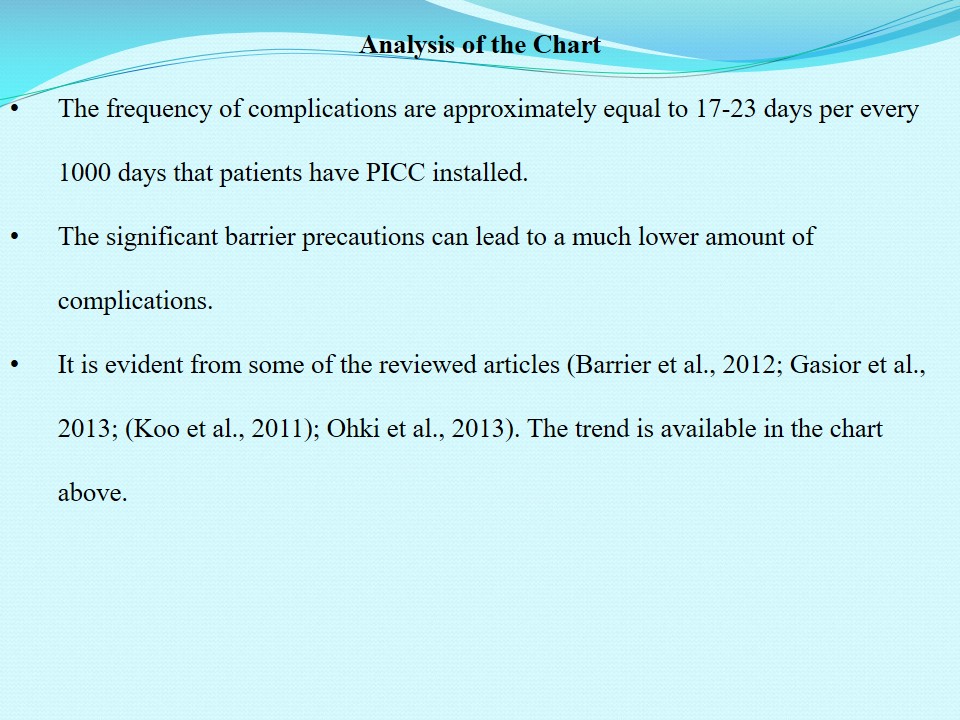
Chart for the Data and Trends
A few details were relevant for comparison from the closed end questions.
They showed how the patients understood the study and their knowledge about PICC and CVC.
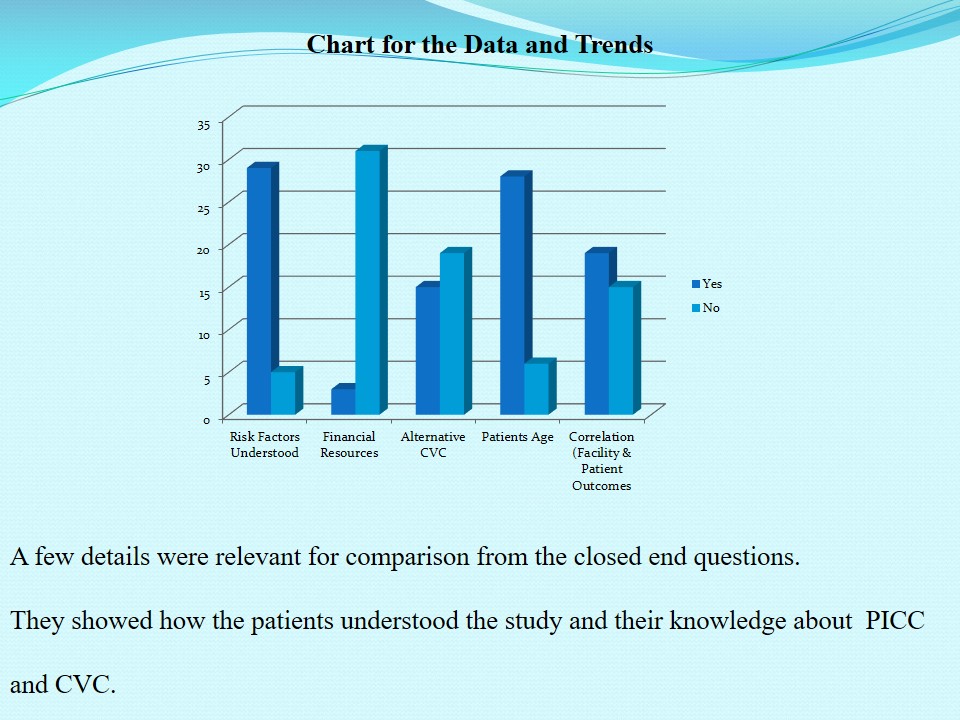
The Two SMART Goals to Facilitate the Plan
- One of the main goals of the investigation is to determine the areas of change and improve the quality of the PICC’s procedure at Kendall Regional Medical Center for the next two years.
- The second goal is determining the nurses’ and patients’ points of conflicts and creating workable solutions for better health care provision in the next one year.
It is imperative to carry out a needs assessment that will help in the identification of risk factors and providing future guidelines for reducing the complications associated with PICC. Having identified the problematic areas, it is essential to initiate the process of change to achieve the needed goal and reduce the complications rate among the patients. The identification of the areas of change will help to achieve the significant improvement of the procedure of the insertion of PICC lines and decrease the number of possible complications. The usage of the given assessment tool might also give rise to the implementation of new procedures or introduction of new measures to improve the outcomes.
The complications from PICC require proactive actions to guarantee the safety of patients.
The philosophy of prioritizing responsibility and professionalism is of utmost importance.
There is the necessity for the creation of the efficient assessment tool to investigate a certain sphere of human activity aiming at its improvement.
Patients can be treated with respect without being distressed. While compassion is the primary motivation for reassuring the patient’s well-being, the professional approach and responsible attention to details are the two instruments which secure the successful outcome and exclude errors at every stage of nursing.
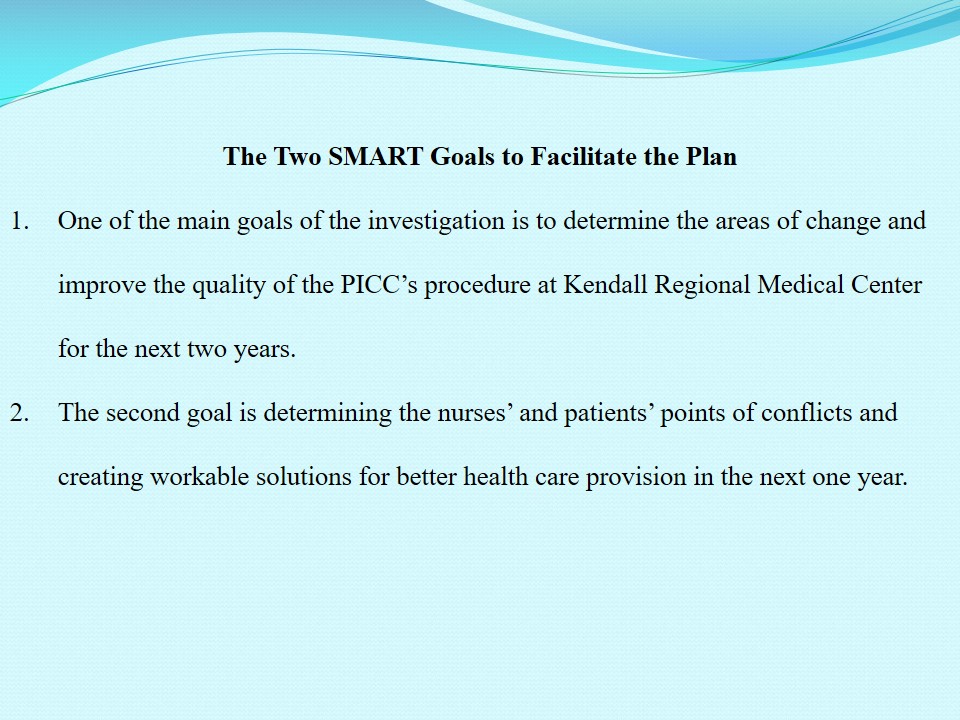
Conclusion
The main aim of the needs assessment is to identify the areas of improvement and create the action plan. It explores the use of the new strategy.
After identifying the problematic areas, it is essential to initiate the process of change to achieve the needed goal and reduce the complications rate among the patients (Weigl et al., 2013).
The identification of the areas of change will help to achieve the significant improvement of the procedure of the insertion of PICC lines and decrease the number of possible complications. The usage of the given assessment tool might also give rise to the implementation of new procedures or introduction of new measures to improve the outcome (Kaufman & Guerra-López, 2013).
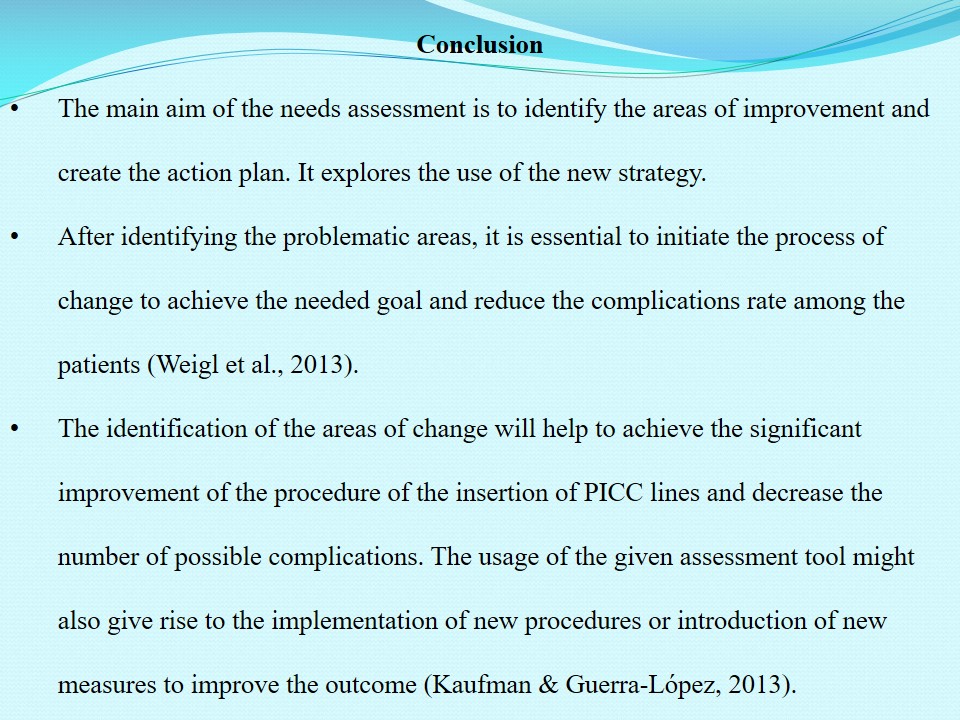
References
Barrier, A., Williams, D. J., Connelly, M., & Creech, C. B. (2012). Frequency of peripherally inserted central catheter complications in children. The Pediatric Infectious Disease Journal, 31(5), 519-521.
Gasior, A. C., Knott, E. M., & Peter, S. D. S. (2013). Management of peripherally inserted central catheter associated deep vein thrombosis in children. Pediatric Surgery International, 29(5), 445-449.
Kaufman, R., & Guerra-López, I. (2013). Needs assessment for organizational success. New York, NY: Oxford University Press.
Koo, B., Erglis, A., Doh, J., Daniels, D., Jegere, S., & Kim, H. (2011). Diagnosis of ischemia-causing coronary stenosis by noninvasive fractional flow reserve computed from coronary computed tomographic angiosperms, JACC, 58(19), 1989-1997.
Levy, I., Bendet, M., Samra, Z., Shalit, I., & Katz, J. (2010). Infectious complications of peripherally inserted central venous catheters in children. The Pediatric Infectious Disease Journal, 29(5), 426-429.
Marsden, A.L. (2013). Simulation based planning of surgical interventions in pediatric cardiology, Phys. Fluids, 25(101303), 1-20.
Ohki, Y., Maruyama, K., Harigaya, A., Kohno, M., & Arakawa, H. (2013). Complications of peripherally inserted central venous catheter in Japanese neonatal intensive care units. Pediatrics International, 55(2), 185-189.
Pai, F.H. & Huang, K.I. (2011). Applying technology acceptance model to the introduction of healthcare information systems. Technological Forecasting and Social Change, 78(4), 650-660.
Rycroft-Malone, J., Seers, K., Chandler, J., Hawkers, C.A., Crichton, N., Allen, C., Bullock, I. & Strunin, L. (2013). The role of evidence, context, and facilitation in an implementation trial: Implications for the development of the PARIHS framework. Implementation Science, 8(28), 1-13.
Weigl, B., Gaydos, C., Kost, G., Bayette, F., Stephanie, S., Rompalo, A., Haller, J. (2013). The value of clinical needs assessments for point-of-care diagnostics. Point Care, 11(2).